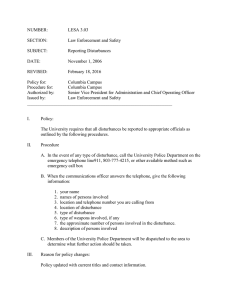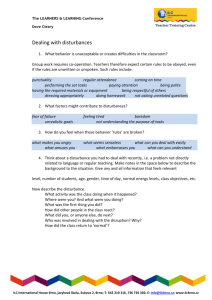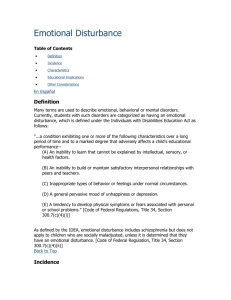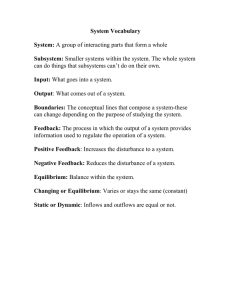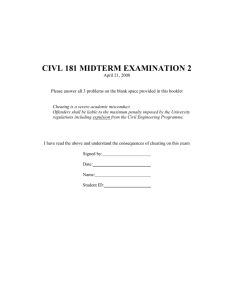Effect of Disturbance on Closed-Loop Control System
advertisement
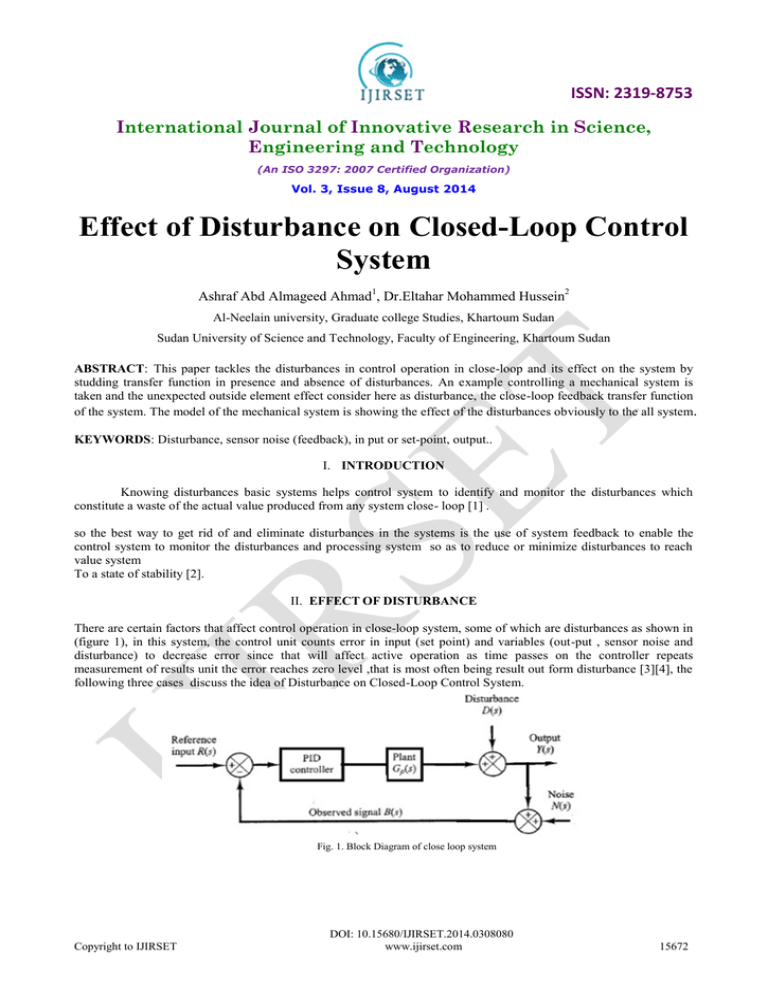
ISSN: 2319-8753 International Journal of Innovative Research in Science, Engineering and Technology (An ISO 3297: 2007 Certified Organization) Vol. 3, Issue 8, August 2014 Effect of Disturbance on Closed-Loop Control System Ashraf Abd Almageed Ahmad1, Dr.Eltahar Mohammed Hussein2 Al-Neelain university, Graduate college Studies, Khartoum Sudan Sudan University of Science and Technology, Faculty of Engineering, Khartoum Sudan ABSTRACT: This paper tackles the disturbances in control operation in close-loop and its effect on the system by studding transfer function in presence and absence of disturbances. An example controlling a mechanical system is taken and the unexpected outside element effect consider here as disturbance, the close-loop feedback transfer function of the system. The model of the mechanical system is showing the effect of the disturbances obviously to the all system. KEYWORDS: Disturbance, sensor noise (feedback), in put or set-point, output.. I. INTRODUCTION Knowing disturbances basic systems helps control system to identify and monitor the disturbances which constitute a waste of the actual value produced from any system close- loop [1] . so the best way to get rid of and eliminate disturbances in the systems is the use of system feedback to enable the control system to monitor the disturbances and processing system so as to reduce or minimize disturbances to reach value system To a state of stability [2]. II. EFFECT OF DISTURBANCE There are certain factors that affect control operation in close-loop system, some of which are disturbances as shown in (figure 1), in this system, the control unit counts error in input (set point) and variables (out-put , sensor noise and disturbance) to decrease error since that will affect active operation as time passes on the controller repeats measurement of results unit the error reaches zero level ,that is most often being result out form disturbance [3][4], the following three cases discuss the idea of Disturbance on Closed-Loop Control System. Fig. 1. Block Diagram of close loop system Copyright to IJIRSET DOI: 10.15680/IJIRSET.2014.0308080 www.ijirset.com 15672 ISSN: 2319-8753 International Journal of Innovative Research in Science, Engineering and Technology (An ISO 3297: 2007 Certified Organization) Vol. 3, Issue 8, August 2014 Case 1: If disturbances value and sensor noise signal (feedback signal) being disabled to zero point and the PID controller is Gp(s) , error process variables and transfer function are given by input and output only. These changes in input cause the controller unit to perform a new successive controlling effect that in turn drive variables processes upwards or down according to physical characteristics processing in Figure (2) ,[5]. Figure (2) close loop system with no disturbance and sensor noise …(1) …(2) Disturbances = 0 𝑁𝑜𝑖𝑠𝑒 = 0 𝑌(𝑠) 𝑅(𝑠) = 𝐾𝑝 𝐺𝑃 (𝑠) ( 1+ 𝐾𝑝 𝐺𝑝 (𝑠) …(3) Case 2: If sensor noise signal ( feedback signal ) and input are completely disabled or at least constant , the main closed-loop diagram can be counted and rearranged in order to explain the way disturbances affect in process variable " the original control loop diagram can be rearranged mathematically to show how disturbances affect the process variable. Disturbances pass through a modified process that is mathematically equivalent to the original process being driven by a feedback signal passing through the controller "[6] Figure (3) . Figure (3) close loop system with no input R(s) and sensor noise N s = 0 𝑎𝑛𝑑 𝑅 𝑠 = 0 𝑌(𝑠) 1 = … (4) … (5) 𝐷 𝑠 =𝑌 𝑠 … (6) 𝐷(𝑠) 1+ 𝐾𝑝 𝐺𝑝 (𝑠) 1 + 𝐾𝑝 𝐺𝑝 𝑠 Case 3: Close loop system using feedback technique by adding the output signal to the input signal this error is having a better output response .One of the disadvantage of the open loop system its effects and sensitivity to disturbance using close loop feedback system is helpful on solving the disturbance so to compensate it by measuring the output Copyright to IJIRSET DOI: 10.15680/IJIRSET.2014.0308080 www.ijirset.com 15673 ISSN: 2319-8753 International Journal of Innovative Research in Science, Engineering and Technology (An ISO 3297: 2007 Certified Organization) Vol. 3, Issue 8, August 2014 compared with the input signal . Then the system responses due to that relation and act correspond , and also the closed loop system is less noise sensitivity compared with open loop system [7][8] in Figure (1). 𝑌 𝑠 = 𝐾𝑝 𝐺𝑝 𝑠 (1+ 𝐾𝑝 𝐺𝑝 𝑠 ) 𝑅(𝑠) − 𝐾𝑝 𝐺𝑝 (𝑠) ( 1+ 𝐾𝑝 𝐺𝑝 𝑠 ) 𝑁(𝑠) + 1 ( 1+ 𝐾𝑝 𝐺𝑃 𝑠 ) 𝐷 (𝑠) …(7) …(8) 𝐸(𝑠) = 𝑅(𝑠) − 𝑌(𝑠) 𝐸 𝑠 = 1 1+𝐾𝑃 𝐺𝑝 (𝑠) 𝑅 𝑠 + 𝐾𝑝 𝐺𝐾 (𝑠) 1+ 𝐾𝑝 𝐺𝑝 (𝑠) 𝑁 𝑠 − 1 1+ 𝐾𝑝 𝐺𝑝 𝑠 …(9) 𝐷 𝑠 III. MODEL identification of subsystem parameters such as road grade (μ hill) which represent the disturbance (µ engine) and represent the vehicle engine (Vb) represent the desired velocity, In this modelled for the dynamic response of the car the noise was ignored . Case study of disturbance for mechanical system: Vehicle drive through hills the aim is constant velocity: Figure (3)Vehicle drive through hills the aim is constant velocity mv = −bv + μ engine + μhill μ engine = k Vdes − V 𝐾 1 𝑉𝑠𝑠 = 𝑉𝑑𝑒𝑠 + 𝜇𝑖𝑙𝑙 ... (10) … (11) … (12) Vss → Vdes as K → ∞ … (.13) 𝑏+𝐾 𝑏+𝐾 Steady state velocity approaches desired velocity as k → ∞. and Disturbance rejection Effect of disturbances (eg, hills) approaches zero as k → ∞. Robustness results don’t depend on the specific values of b, m or k, for k sufficiently large[11]. 𝑠 20𝑁 Let 𝑚 = 3𝑘𝑔 𝑏 = 10 𝑁. 𝜇𝑖𝑙𝑙 = 𝑓 = 1 𝑁 … (14) 𝑚 𝑚 By plugging these values in the transfer function: The goal of this problem is to show you how each of the following contribute to obtain: fast rise time, minimum overshoot, no steady-state error. K p , K i and K d Figure (4) transfer function of velocity drive example Copyright to IJIRSET DOI: 10.15680/IJIRSET.2014.0308080 www.ijirset.com 15674 ISSN: 2319-8753 International Journal of Innovative Research in Science, Engineering and Technology (An ISO 3297: 2007 Certified Organization) Vol. 3, Issue 8, August 2014 The closed loop transfer function is given by: Y(s) R(s) 𝑌(𝑠) 𝑅(𝑠) = = K p +K d s s 2 +10s +20 K p +K d s 1+ 2 s +10s +20 …(15) 𝐾𝑝 +𝐾𝑑 𝑠 𝑠 2 + 10+𝐾𝑑 𝑠+(20+ 𝐾𝑝 ) …(16) let 𝐾𝑝 = 30 , 𝐾𝑖 = 70 The proportional gain be reduced because the integral controller also reduces the rise time and increases the overshoot as the proportional controller does (double effect), figure (5) present that the integral controller eliminated the steady-state error [9][10]. Figure (5) close – loop step kp =30 ki = 70 The algorithm automatically generates mask image without user interaction that contains only text regions to be inpainted. IV. . RESULT The effect of disturbance is changing the purpose or reduce the efficiency of the output, Using closed loop transfer function reduce this effect to minimize the disturbance as possible. The disturbance reduction using PID controller participates to eliminate the disturbance effect. V. CONCLUSION Disturbances affect the closed-loop control systems and this is what became clear out by using a transfer function, any system that contains disturbances may be calculated or uncalculated but must disturbances account for processing system. Reduce disturbances values lead to the stability of the system and whenever a disturbances value close to zero this leads stability of system be high. . REFERENCES [1] John Doyle - Bruce Francis, , Allen Tannenbaum, Feedback Control Theory, pp 27-30, c Macmillan Publishing Co., 1990. Copyright to IJIRSET DOI: 10.15680/IJIRSET.2014.0308080 www.ijirset.com 15675 ISSN: 2319-8753 International Journal of Innovative Research in Science, Engineering and Technology (An ISO 3297: 2007 Certified Organization) Vol. 3, Issue 8, August 2014 [2] [3] [4] [5] [6] [7] [8] [9] [10] [11] gangrene Duane , Disturbance attenuation in linear systems via observed based compensator: a parametric Eigen structure assignment approach, ying-xin yan and dong honglin .in international journal of information and systems sciences solume 2, number 1, Pages 144153 (2006). Karl Johan Astrom ,Control system design , Lecture notes for ME 155A, pp 216 225http://www.cds.caltech.edu/~murray/courses/cds101/fa02/caltech/astrom.html, 2002. Dr.Harrison Chin, Feedback Control System Design 2.017 Fall 2009 10/29/2009,http://ocw.mit.edu/courses/mechanical-engineering/2-017jdesign-of-electromechanical-robotic-systems-fall-2009/lecture-notes/MIT2_017JF09_control.pdf Katsuhiko Ogata. Modern Control Engineering , pp 700-716 , Fourth Edition . Prentice-Hall, Inc. Upper Saddle Ri\ er, New Jersey 07458 ,2002 Behavior.Vance Van Doren ,Disturbance RejectionVs . http://www.controleng.com/single-article/disturbance-rejection-vs-setpoint-trackingcontrollers/fe8b0cf50a2f0000c3b647c7e36326af.html.2011 Norman S. Nise, CONTROL SYSTEMS ENGINEERING .Sixth Edition, California State Polytechnic University, Pomona 2010. Roland Burns, Advanced Control Engineering , oxford Auckland Johannesburg, Melbourne new Delhi ,2001 . Introduction: PID Controller Design. www.http://ctms.engin.umich.edu/CTMS/index.php?example=Introduction&section=ControlPID#10, 2014 the University of Michigan. PID Tutorial . http://www2.ensc.sfu.ca/people/faculty/saif/ctm/PID/PID.html,2014 Basic Properties of Feedback http://www.powershow.com/view/7ccdd ZjA3Z/Chapter_4_Basic_Properties_of_Feedback_powerpoint_ppt_presentation ,2014. Copyright to IJIRSET DOI: 10.15680/IJIRSET.2014.0308080 www.ijirset.com 15676
